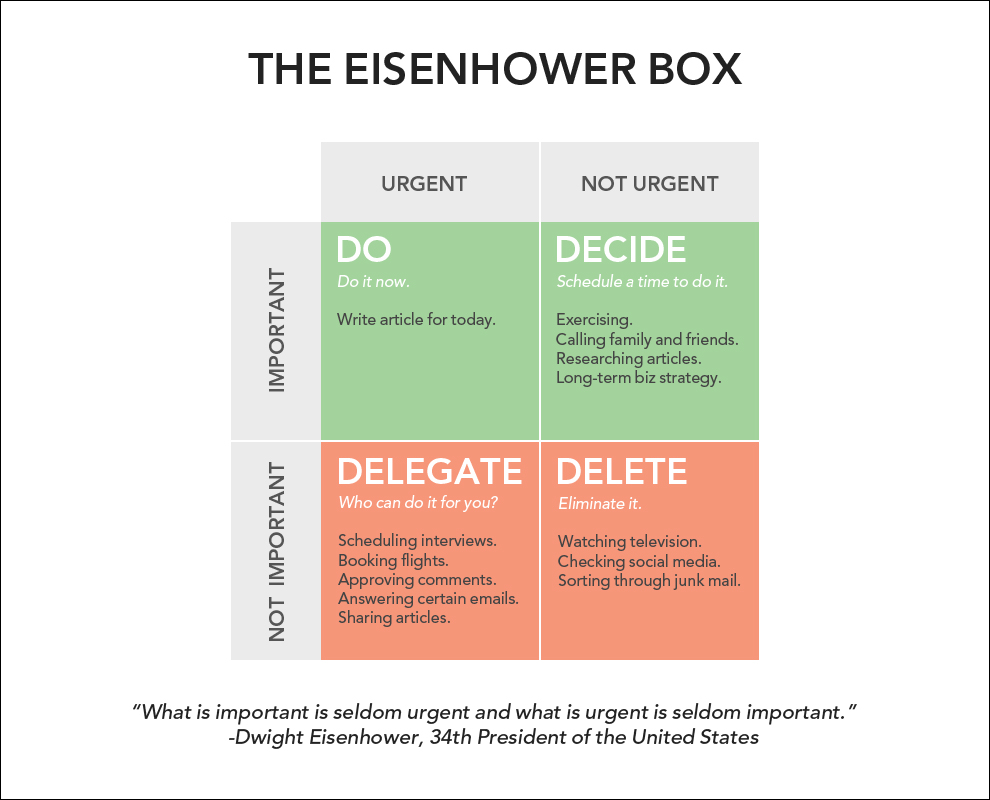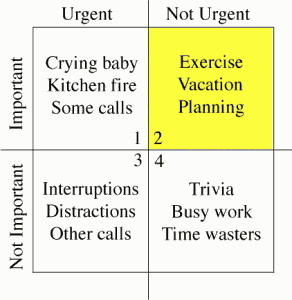Prioritisation part I – Part of the Productivity Series
Learn from one of the greatest military commanders of all time how to prioritise tasks. In this day and age where we are overloaded with information it can often be very difficult to decide where we should focus our efforts. This article outlines a simple decision-making framework for prioritisation.
This is the third article in our series about Productivity. If you haven’t read the first couple of articles, we suggest that you read the first one, which sets the scene for the entire series, here. You can also read the previous article, which was all about goal setting. In this article and the next, we’ll be looking closer at the importance of prioritisation – or the art of prioritising your activities in order to achieve your goals.
You will often find that you face conflicting demands on your time, i.e. that there just aren’t enough hours in the day to get everything done. This is one of the main causes of stress. Thankfully, by focusing on improving your prioritisation skills you can start to do the right things, achieve your goals and feel a lot better about yourself.
In this article we want to introduce you to a simple, but incredibly effective tool for prioritisation. By using this you will immediately be able to discern which of your tasks and activities you should be spending your time on completing, which ones to fit in to left over available time – and which ones to try to remove completely!
Prioritisation using the Eisenhower matrix
Former US President, and erstwhile commander of the Supreme Headquarters Allied Expeditionary Force (SHAEF), Dwight D. Eisenhower (1890 – 1969) has a quote attributed to him:
“What is important is seldom urgent and what is urgent is seldom important.”
Based on this he was said to use a decision making matrix known as the Eisenhower Matrix, or alternatively the Eisenhower Box or the Eisenhower Decision Matrix.
In all its simplicity it asks you to group your tasks based on two criteria: Importance and Urgency. All tasks are then assigned to the relevant box in the quadrant of the matrix and will give you guidelines as to how you need to handle them.
The examples given by Wikipedia are as follows:
- Important/Urgent quadrants are done immediately and personally (e.g. crises, deadlines, problems)
- Important/Not Urgent quadrants get an end date and are done personally (e.g. relationships, planning, recreation)
- Unimportant/Urgent quadrants are delegated (e.g. interruptions, meetings, activities)
- Unimportant/Not Urgent quadrants are dropped (e.g. time wasters, pleasant activities, trivia)
Visualising this prioritisation matrix is straight forward:
The boxes are often numbered (going from left to right on the top row you find boxes 1 and 2 and bottom row from left to right boxes 3 and 4) as seen below.
There are two key notes to be made about the prioritisation matrix:
- If you don’t spend enough time planning the important (long term) activities in box 2 (or “Decide” according to the box above) they will end up either a) becoming urgent, or b) never get done.
- If you don’t eliminate the tasks in box 4 (“Delete”) they will end up becoming box 3 (“Delegate”) items.
In our last article about goal setting we talked about identifying SMART goals and all of these would fall in to box 2 – and so this is where you need to focus your efforts. It is clear that if there is an emergency (such as a building being on fire) you need to deal with this first in box 1, but the real issue is that most people tend to spend their time on the tasks that are urgent, but not important (the tasks in box 3, “Delegate”). We need to get to a better understanding of how we can best utilise the resources at our disposal so that anything that can effectively (both time and cost wise) be outsourced should be delegated or outsourced*.
Just sit back for a second and think about what you actually do during any given work day… How often do you feel you achieve everything you wanted to achieve during the day? How often do you feel that the day just “disappeared” as you got caught up in a number of minor firefighting exercises, meetings, phone calls or emails demanding your urgent attention? And now ask yourself this… How often do you feel that what you actually spent your time on – rather than what you wanted to spend your time on – helped the business (or your personal life) achieve what you expected?
How do we expect to actually achieve goals such as learning new languages or other work or personal skills if we don’t focus and dedicate our most valuable resource, time, to them? If you want to achieve these goals you need to ensure that you assign enough time to deal with the tasks in box 2 – and try to eliminate (through ignoring or just politely declining) tasks in box 4.
In order to be able to achieve this you will need to do one thing:
Be disciplined.
Set aside time to solely focus on the important tasks – eliminating ALL distractions
As a small exercise it’s worth looking at what things you do in a typical day – both privately and at work – and using the prioritisation matrix above organise them into the various categories. This should give you some food for thought and hopefully also show you where you can immediately find some more time to actually get things done.
In a future article in this series we will be looking more in-depth at how you can plan your day to do the tasks that will help you, your team and your organisation achieve your goals. Next time we will have another article about prioritisation and how you can organise your tasks and activities effectively to be much more productive than you are today. As an added bonus, this is effectively also a framework for how you can work better with your peers, bosses, employees, and even family and friends to improve your prioritisation and achieve a higher degree of productivity and goal achievement.
* One of the key benefits of Honeydew Health / Absencehub.com’s Engage absence management software is that it helps you focus your efforts on building your business (box 2) rather than dealing with tasks that can be done more effectively both cost and time wise (box 3 – “Delegate”). Even better if your box 2 goals include increased corporate productivity, cost savings and increased profits then that’s also where our solution comes in.


